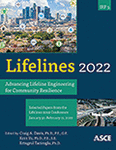Structural Damage Detection under Uncertain Parameters Using Non-Probabilistic Meta-Model and Interval Mathematics
Publication: Lifelines 2022
ABSTRACT
Rapid progress in the field of sensor technology has led to acquisition of massive amounts of measured data from structures being monitored. The data, however, contain inevitable measurement errors which often cause quantitative damage assessment to be ill conditioned. Attempts to incorporate a probabilistic method into a model have provided promising solutions to this problem by treating the uncertainties as random variables usually modeled with Gaussian distribution. However, the success enjoyed by the probabilistic method is limited by the lack of adequate information to obtain an unbiased probabilistic distribution of uncertainties. In addition, the probabilistic surrogate models involve complex and expensive computations, especially when generating output data. In this study, a non-probabilistic surrogate model based on wavelet weighted least squares support vector machine (WWLS-SVM) is proposed to address the problem of uncertainty in vibration based damage detection. The input data for WWLS-SVM consists of selected wavelet packet decomposition (WPD) features of the structural response signals, and the output is the Young’s modulus of structural elements. This method calculates the lower and upper boundaries of the changes in the Young’s modulus based on an interval analysis method. Considering the uncertainties in the input parameters, the surrogate model is used to predict the output of this interval bound. The proposed approach is applied to detect simulated damage in the four-story benchmark structure of IASC-ASCE SHM group. The results show that the proposed method can perform well in uncertainty-based damage detection of structures with less computational efforts compared to direct finite element model.
Get full access to this article
View all available purchase options and get full access to this chapter.
REFERENCES
Abdulkareem, M., and N. Bakhary. 2018. “Non-Probabilistic Wavelet Method to Consider Uncertainties in Structural Damage Detection.” Journal of Sound and Vibration 433:77–98.
Avci, O., O. Abdeljaber, S. Kiranyaz, M. Hussein, M. Gabbouj, and D. J. Inman. 2020. “A Review of Vibration-Based Damage Detection in Civil Structures: From Traditional Methods to Machine Learning and Deep Learning Applications.” ArXiv Preprint ArXiv:2004.04373.
Bakhary, N., H. Hao, and A. J. Deeks. 2007. “Damage Detection Using Artificial Neural Network with Consideration of Uncertainties.” Engineering Structures 29(11):2806–15.
Boller, C. 2009. “Structural Health Monitoring—An Introduction and Definitions.” in Encyclopedia of Structural Health Monitoring. Wiley Online Library.
Ghasemi, M. R., R. Ghiasi, and H. Varaee. 2018. “Probability-Based Damage Detection of Structures Using Surrogate Model and Enhanced Ideal Gas Molecular Movement Algorithm.” Pp. 1657–74 in Advances in Structural and Multidisciplinary Optimization: Proceedings of the 12th World Congress of Structural and Multidisciplinary Optimization (WCSMO12), edited by A. Schumacher, T. Vietor, S. Fiebig, K.-U. Bletzinger, and K. Maute. Cham: Springer International Publishing.
Ghiasi, R., P. Torkzadeh, and M. Noori. 2016. “A Machine-Learning Approach for Structural Damage Detection Using Least Square Support Vector Machine Based on a New Combinational Kernel Function.” Structural Health Monitoring 15(3).
Ghiasi, R., and M. R. Ghasemi. 2018. “Optimization-Based Method for Structural Damage Detection with Consideration of Uncertainties-a Comparative Study.” Smart Structures and Systems 22(5):561–74.
He, H.‐X., and W.‐M. Yan. 2007. “Structural Damage Detection with Wavelet Support Vector Machine: Introduction and Applications.” Structural Control and Health Monitoring 14(1):162–76.
Johnson, E. A., H. F. Lam, L. S. Katafygiotis, and J. L. Beck. 2003. “Phase I IASC-ASCE Structural Health Monitoring Benchmark Problem Using Simulated Data.” Journal of Engineering Mechanics 130(1):3–15.
Kook Oh, C. 2007. “Bayesian Learning for Earthquake Engineering Applications and Structural Health Monitoring.”
Lantz, B. 2013. “Black Box Methods—Neural Networks and Support Vector Machines.” Machine Learning with R; Jones, J., Sheikh, A., Eds 205–42.
Nazin, S. A., and B. T. Polyak. 2005. “Interval Parameter Estimation under Model Uncertainty.” Mathematical and Computer Modelling of Dynamical Systems 11(2):225–37.
Oh, C. K., and J. L. Beck. 2018. “A Bayesian Learning Method for Structural Damage Assessment of Phase I IASC-ASCE Benchmark Problem.” KSCE Journal of Civil Engineering 22(3):987–92.
Padil, K. H., N. Bakhary, and H. Hao. 2017. “The Use of a Non-Probabilistic Artificial Neural Network to Consider Uncertainties in Vibration-Based-Damage Detection.” Mechanical Systems and Signal Processing 83:194–209.
Qiu, Z., and L. Wang. 2016. “The Need for Introduction of Non-Probabilistic Interval Conceptions into Structural Analysis and Design.” Science China Physics, Mechanics & Astronomy 59(11):114632.
Ravanfar, S. A., H. Abdul Razak, Z. Ismail, and S. J. S. Hakim. 2014. “Damage Detection Based on Wavelet Packet Transform and Information Entropy.” Pp. 223–29 in Structural Health Monitoring, Volume 5. Springer.
Shu, J., Z. Zhang, I. Gonzalez, and R. Karoumi. 2013. “The Application of a Damage Detection Method Using Artificial Neural Network and Train-Induced Vibrations on a Simplified Railway Bridge Model.” Engineering Structures 52:408–21.
Suykens, J. A. K., J. De Brabanter, L. Lukas, J. Vandewalle, and J. De Brabanter. 2002. “Weighted Least Squares Support Vector Machines: Robustness and Sparse Approximation.” Neurocomputing 48(1):85–105.
Suykens, J. A. K., and J. Vandewalle. 1999. “Least Squares Support Vector Machine Classifiers.” Neural Processing Letters 9(3):293–300.
Toh, G., and J. Park. 2020. “Review of Vibration-Based Structural Health Monitoring Using Deep Learning.” Applied Sciences 10(5):1680.
Yen, G. G., and K. C. Lin. 2000. “Wavelet Packet Feature Extraction for Vibration Monitoring.” IEEE Transactions on Industrial Electronics 47(3):650–67.
Yuen, K.-V., S. Kui Au, and J. L. Beck. 2004. “Two-Stage Structural Health Monitoring Approach for Phase I Benchmark Studies.” Journal of Engineering Mechanics 130(1):16–33.
Information & Authors
Information
Published In
History
Published online: Nov 16, 2022
Authors
Metrics & Citations
Metrics
Citations
Download citation
If you have the appropriate software installed, you can download article citation data to the citation manager of your choice. Simply select your manager software from the list below and click Download.
